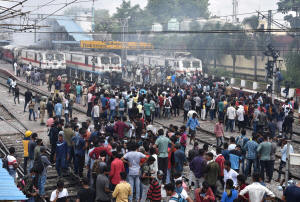One dead in India unrest over military hiring, some gatherings banned
 Send a link to a friend
Send a link to a friend
 [June 17, 2022]
By Devjyot Ghoshal and Saurabh Sharma [June 17, 2022]
By Devjyot Ghoshal and Saurabh Sharma
NEW DELHI (Reuters) -Authorities imposed
restrictions on Friday on gatherings in a satellite city of India's
capital that is home to offices of several multinational firms, and one
person was killed as protests against a new military recruitment process
spread.
Prime Minister Narendra Modi's government unveiled the new recruitment
system this week, called Agnipath or "path of fire" in Hindi, triggering
turmoil with police firing into the air to break up stone-throwing
crowds and the torching of railway infrastructure.
The system aims to bring in more people to the military on short,
four-year contracts to lower the average age of India's 1.38
million-strong armed forces and cut down on burgeoning pension costs.
But many potential recruits object, concerned about employment
opportunities after serving their four-year terms and disappointed to
miss out on a pension, and thousands of young men took to the streets on
Friday, with protests turning violent in at least three states.
One protester was killed in a clash with police in the southern city of
Secunderabad, a government official said.
The administration of Gurugram district, south of New Delhi, said no
more than four people could gather at one place in an effort to
forestall demonstrations.
"This order shall come into force with immediate effect," Gurugram's
administration said in a notice, a copy of which was posted on social
media by district's information department.

While there have been no reports of protests in Gurugram, some
demonstrators were out in the neighbouring district of Palwal on
Thursday.
Some of the world's major companies have offices in Gurugram including
Microsoft Corp, Meta and Google Inc.. it is also home to manufacturing
facilities of major Indian companies like Maruti Suzuki.
The new recruitment system has drawn criticism from opposition parties,
and even from some members of Modi's ruling Bharatiya Janata Party, who
say it will lead to more unemployment in a country grappling with
joblessness.
[to top of second column]
|

Protestors block railway tracks during a protest against "Agnipath
scheme" for recruiting personnel for armed forces, in Secunderabad
in the southern state of Andhra Pradesh, India, June 17, 2022.
REUTERS/Stringer

The government has said the armed forces aim to
recruit about 46,000 people under the new system this year, and will
keep only 25% of them on at the end of their four-year terms.
'NO PENSION'
In the northern state of Uttar Pradesh, protests erupted in 14
districts, and police fired into the air to push back stone-throwing
crowds, senior police official Prashant Kumar said.
"The police are trying to disperse protesters by holding talks with
them," Kumar told Reuters.
Avnish Kumar, a 19-year-old from Uttar Pradesh's Ballia district who
hoped to join the army, said he was disappointed with the new
scheme.
"The tenure of the job is only four years and only 25% people will
get job after that," he told Reuters by telephone. "There is no
pension."
In neighbouring Bihar state, protesters torched train coaches in at
least two stations and disrupted rail services, police said.
Hundreds of people gathered in Secunderabad in the south, clashing
with police and setting fire to railway station property, police
said.
The new process will bring in men and women between the ages of
17-and-a-half and 21 for a four-year tenure at non-officer ranks,
with only a quarter retained for longer.
Soldiers have previously been recruited by the army, navy and air
force separately, and typically serve for up to 17 years, for the
lowest ranks.
The government on Friday also announced a one-time extension for the
maximum entry age into the scheme to 23 since recruitment had been
frozen for the past two years because of the COVID-19 pandemic.
(Additional reporting by Jatindra Dash; Editing by Robert Birsel)
[© 2022 Thomson Reuters. All rights
reserved.]
This material may not be published,
broadcast, rewritten or redistributed.
Thompson Reuters is solely responsible for this content. |